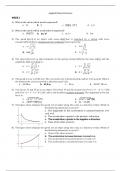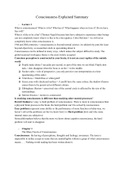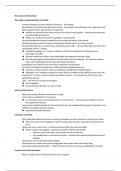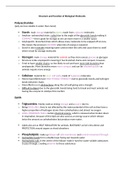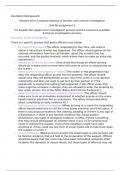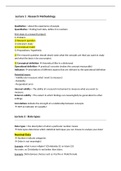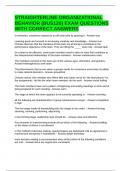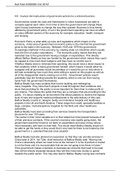Applied Natural Sciences
WEEK 1
1) What is the unit in which work is expressed?
a. N b. J c. [M][L] / [T2] d. J /s
2) What is the unit in which acceleration is expressed?
a. [M][T2] b. m / s2 c. m / s d. J m
3) The speed v[m/s] of an object with mass m[kg] that is launched by a spring with force
constant k[N/m] that is compressed over a distance L[m] is given by:
𝑘 𝑚
a. v=√ c. v=𝐿√
𝐿∗𝑚 𝑘
𝒌 𝑘
b. v=𝑳√ d. v=√𝐿 𝑚
𝒎
4) The speed v[m/s] of an object depends on the spring constant k[N/m], the mass m[kg], and the
amplitude A[m] according to:
3 𝑚 3 𝑘𝐴
a. 𝑣 = √ √ 𝐴 c. 𝑣 = √4 √ 𝑚
4 𝑘
3 𝑚𝐴 𝟑 𝒌
b. 𝑣 = √4 √ d. 𝒗 = √𝟒 √𝒎 𝑨
𝑘
5) The speed of a car is 10.00 m/s. The car travels over a flat horizontal road for 4.10 seconds. What is
the distance the car has traveled in that time span? (x2)
a. 41.00 m b. 41.0 m c. 41 m d. 4.100 * 101 m
6) Two forces F1 and F2 act on an object. The forces F1 and F2 are given by F1=(a * i^ −b * j ^) [N]
and F2=(−b * j^ + a * k^) [N] , with a and b unitless positive constants. The magnitude of the net
force is:
a. √2 (𝑎2 + 𝑏 2 ) [N] c. √𝟐 𝒂𝟐 + 𝟒𝒃𝟐 [N]
b. √2 𝑎2 − 4𝑏 2 [N] d. 2𝑎 − 2𝑏 [N]
7) The figure above displays the speed v of an object along the x-axis as a function of time. Which of
the following statements is correct?
a. The magnitude of the acceleration is constant between t=t1
and t=t2
b. The acceleration a points in the positive x-direction
c. The acceleration a points in the negative x-direction.
d. None of the other answers.
8) The figure above displays the speed v of an object along the x-axis as a function of time. Which of
the following statements is correct?
a. None of the other answers.
b. The acceleration increases between t=t1 and t=t2
c. The acceleration decreases between t=t1 and t=t2
d. The acceleration is constant between t=t1 and t=t2
,9) The graph above displays the speed v of an object that is moving along the x-axis as a function of
time. Which of the following statements is correct?
a. The average acceleration between t=t1 and t=t3 is
equal to the instantaneous acceleration at t=t2.
b. The average acceleration between t=t1 and t=t3 is
equal to the instantaneous acceleration at a moment
between t=t2 and t=t3.
c. The average acceleration between t=t1 and t=t3 is
equal to the instantaneous acceleration at a moment
between t=t1 and t=t2.
d. The average acceleration between t=t1 and t=t2 is equal to the acceleration
between t=t2 and t=t3.
e. One cannot tell whether one of the other answers is correct or not because the
average acceleration cannot be determined.
10) The average acceleration aavg−x of an object moving from position x1 at t=t1 and position x2
at t=t2 is defined as:
𝑥 𝑥
a. aavg-x = ½ ( 𝑡 21+ 𝑡 22) c. The average acceleration cannot be
1 2
𝑥 /𝑡 +𝑥 /𝑡 determined from the positions only.
b. aavg-x = 1 𝑡1 −𝑡 2 2 d.
𝑥 𝑥
aavg-x = ½ ( 𝑡 1+ 𝑡 2)
2 1
1 2
11) The average acceleration vavg−x of an object moving from position x1 at t=t1 and position x2
at t=t2 is defined as:
𝒙 +𝒙 𝑥 𝑥
a. vavg-x = 𝟏 𝟐 c. vavg-x = ½ ( 𝑡 1+ 𝑡 2)
𝒕𝟐 −𝒕𝟏 1 2
𝑥 𝑥 𝑥1 + 𝑥2
b. vavg-x = ½ ( 𝑡 1- 𝑡 2) d. vavg-x = 𝑡2 −𝑡1
1 2
12) You are standing on the edge of a building at height H above ground level. You throw a ball straight
upward with initial speed v0. The ball experiences a constant gravitational acceleration g and no
air friction. We take the y-axis pointing straight upward (i.e. the positive y-direction is upward)
and the origin (y=0) at ground level. Which of the following equations describes the position of
the ball as a function of time? (x2)
1
a. 𝑦(𝑡) = −𝑣0 + 2 𝑔𝑡 2
1
b. 𝑦(𝑡) = 𝑣0 𝑡 + 2 𝑔𝑡 2
1
c. 𝑦(𝑡) = 𝐻 − 𝑣0 𝑡 − 2 𝑔𝑡 2
𝟏
d. 𝒚(𝒕) = 𝑯 + 𝒗𝟎 𝒕 − 𝟐 𝒈𝒕𝟐
13) The graph above shows the speed as a function of time of an object that moves along the x-axis.
Which of the graphs below shows the acceleration of the object as a function of time?
a. A
b. B
c. C
d. D
e. E
f. F
g. G
h. H
, 14) The graph above shows the acceleration as a function of time of an object that moves along the x-
axis.Which of the graphs below shows the velocity of the object as a function of time?
a. A
b. B
c. C
d. D
e. E
f. F
g. G
h. H
15) What are the average velocity, vavg, and average acceleration, aavg, of an object in a uniform
circular motion for one revolution?
a. vavg > 0 and aavg > 0 c. vavg > 0 and aavg < 0 e. vavg = 0 and aavg = 0
b. vavg < 0 and aavg < 0 d. vavg = 0 and aavg < 0 f. vavg > 0 and aavg = 0
16) The figure above shows the trajectory of a space craft leaving earth.
What is the direction of the average velocity vector of the space craft
in the time interval t=0 s to t=2 s? (x2)
a. (+x, -y) direction
b. (+x, +y) direction
c. (-x, +y) direction
d. (-x, -y) direction
17) You are standing on the edge of a high cliff. You throw a ball with speed v0 under an angle α with
the horizontal plane. A positive angle α means upward (α=π/2 is straight upward); a negative
angle α means downward (α=−π/2 is straight downward). Air resistance can be neglected and
the gravitational acceleration is g. The figure above shows the
magnitude of the velocity ∣v∣ of the ball as a function of time for
angles α=−π/4, α=0, α=+π/4, and α=+π/2, but in random order.
All the graphs have an equal scale. Put the graphs in the correct order
of increasing angles. (x2)
a. D-C-B-A
b. B-C-D-A
c. A-D-C-B
d. C-B-A-D
18) A soccer player on a horizontal playground kicks a ball away under a certain angle with the
playground. The ball can be considered to be a projectile. Air resistance can be neglected and the
gravitational acceleration is g. After a time T the ball is back on the ground. What was the
maximum height H of the ball's trajectory?
a. H = gT2 1
c. H = 2gT2
1 2
b. H = 4gT 𝟏
d. H = 𝟖gT2
19) A soccer player on a horizontal playground kicks a ball away with a velocity v0 under an
angle α with the playground. The ball can be considered to be a projectile. Air resistance can be
neglected and the gravitational acceleration is g. During the trajectory, the ball reaches a
maximum height H. Now he kicks a second ball under the same angle but with double velocity.
What is the maximum height the second ball will reach?
a. H / 2 c. 4H
b. 2H d. H
WEEK 1
1) What is the unit in which work is expressed?
a. N b. J c. [M][L] / [T2] d. J /s
2) What is the unit in which acceleration is expressed?
a. [M][T2] b. m / s2 c. m / s d. J m
3) The speed v[m/s] of an object with mass m[kg] that is launched by a spring with force
constant k[N/m] that is compressed over a distance L[m] is given by:
𝑘 𝑚
a. v=√ c. v=𝐿√
𝐿∗𝑚 𝑘
𝒌 𝑘
b. v=𝑳√ d. v=√𝐿 𝑚
𝒎
4) The speed v[m/s] of an object depends on the spring constant k[N/m], the mass m[kg], and the
amplitude A[m] according to:
3 𝑚 3 𝑘𝐴
a. 𝑣 = √ √ 𝐴 c. 𝑣 = √4 √ 𝑚
4 𝑘
3 𝑚𝐴 𝟑 𝒌
b. 𝑣 = √4 √ d. 𝒗 = √𝟒 √𝒎 𝑨
𝑘
5) The speed of a car is 10.00 m/s. The car travels over a flat horizontal road for 4.10 seconds. What is
the distance the car has traveled in that time span? (x2)
a. 41.00 m b. 41.0 m c. 41 m d. 4.100 * 101 m
6) Two forces F1 and F2 act on an object. The forces F1 and F2 are given by F1=(a * i^ −b * j ^) [N]
and F2=(−b * j^ + a * k^) [N] , with a and b unitless positive constants. The magnitude of the net
force is:
a. √2 (𝑎2 + 𝑏 2 ) [N] c. √𝟐 𝒂𝟐 + 𝟒𝒃𝟐 [N]
b. √2 𝑎2 − 4𝑏 2 [N] d. 2𝑎 − 2𝑏 [N]
7) The figure above displays the speed v of an object along the x-axis as a function of time. Which of
the following statements is correct?
a. The magnitude of the acceleration is constant between t=t1
and t=t2
b. The acceleration a points in the positive x-direction
c. The acceleration a points in the negative x-direction.
d. None of the other answers.
8) The figure above displays the speed v of an object along the x-axis as a function of time. Which of
the following statements is correct?
a. None of the other answers.
b. The acceleration increases between t=t1 and t=t2
c. The acceleration decreases between t=t1 and t=t2
d. The acceleration is constant between t=t1 and t=t2
,9) The graph above displays the speed v of an object that is moving along the x-axis as a function of
time. Which of the following statements is correct?
a. The average acceleration between t=t1 and t=t3 is
equal to the instantaneous acceleration at t=t2.
b. The average acceleration between t=t1 and t=t3 is
equal to the instantaneous acceleration at a moment
between t=t2 and t=t3.
c. The average acceleration between t=t1 and t=t3 is
equal to the instantaneous acceleration at a moment
between t=t1 and t=t2.
d. The average acceleration between t=t1 and t=t2 is equal to the acceleration
between t=t2 and t=t3.
e. One cannot tell whether one of the other answers is correct or not because the
average acceleration cannot be determined.
10) The average acceleration aavg−x of an object moving from position x1 at t=t1 and position x2
at t=t2 is defined as:
𝑥 𝑥
a. aavg-x = ½ ( 𝑡 21+ 𝑡 22) c. The average acceleration cannot be
1 2
𝑥 /𝑡 +𝑥 /𝑡 determined from the positions only.
b. aavg-x = 1 𝑡1 −𝑡 2 2 d.
𝑥 𝑥
aavg-x = ½ ( 𝑡 1+ 𝑡 2)
2 1
1 2
11) The average acceleration vavg−x of an object moving from position x1 at t=t1 and position x2
at t=t2 is defined as:
𝒙 +𝒙 𝑥 𝑥
a. vavg-x = 𝟏 𝟐 c. vavg-x = ½ ( 𝑡 1+ 𝑡 2)
𝒕𝟐 −𝒕𝟏 1 2
𝑥 𝑥 𝑥1 + 𝑥2
b. vavg-x = ½ ( 𝑡 1- 𝑡 2) d. vavg-x = 𝑡2 −𝑡1
1 2
12) You are standing on the edge of a building at height H above ground level. You throw a ball straight
upward with initial speed v0. The ball experiences a constant gravitational acceleration g and no
air friction. We take the y-axis pointing straight upward (i.e. the positive y-direction is upward)
and the origin (y=0) at ground level. Which of the following equations describes the position of
the ball as a function of time? (x2)
1
a. 𝑦(𝑡) = −𝑣0 + 2 𝑔𝑡 2
1
b. 𝑦(𝑡) = 𝑣0 𝑡 + 2 𝑔𝑡 2
1
c. 𝑦(𝑡) = 𝐻 − 𝑣0 𝑡 − 2 𝑔𝑡 2
𝟏
d. 𝒚(𝒕) = 𝑯 + 𝒗𝟎 𝒕 − 𝟐 𝒈𝒕𝟐
13) The graph above shows the speed as a function of time of an object that moves along the x-axis.
Which of the graphs below shows the acceleration of the object as a function of time?
a. A
b. B
c. C
d. D
e. E
f. F
g. G
h. H
, 14) The graph above shows the acceleration as a function of time of an object that moves along the x-
axis.Which of the graphs below shows the velocity of the object as a function of time?
a. A
b. B
c. C
d. D
e. E
f. F
g. G
h. H
15) What are the average velocity, vavg, and average acceleration, aavg, of an object in a uniform
circular motion for one revolution?
a. vavg > 0 and aavg > 0 c. vavg > 0 and aavg < 0 e. vavg = 0 and aavg = 0
b. vavg < 0 and aavg < 0 d. vavg = 0 and aavg < 0 f. vavg > 0 and aavg = 0
16) The figure above shows the trajectory of a space craft leaving earth.
What is the direction of the average velocity vector of the space craft
in the time interval t=0 s to t=2 s? (x2)
a. (+x, -y) direction
b. (+x, +y) direction
c. (-x, +y) direction
d. (-x, -y) direction
17) You are standing on the edge of a high cliff. You throw a ball with speed v0 under an angle α with
the horizontal plane. A positive angle α means upward (α=π/2 is straight upward); a negative
angle α means downward (α=−π/2 is straight downward). Air resistance can be neglected and
the gravitational acceleration is g. The figure above shows the
magnitude of the velocity ∣v∣ of the ball as a function of time for
angles α=−π/4, α=0, α=+π/4, and α=+π/2, but in random order.
All the graphs have an equal scale. Put the graphs in the correct order
of increasing angles. (x2)
a. D-C-B-A
b. B-C-D-A
c. A-D-C-B
d. C-B-A-D
18) A soccer player on a horizontal playground kicks a ball away under a certain angle with the
playground. The ball can be considered to be a projectile. Air resistance can be neglected and the
gravitational acceleration is g. After a time T the ball is back on the ground. What was the
maximum height H of the ball's trajectory?
a. H = gT2 1
c. H = 2gT2
1 2
b. H = 4gT 𝟏
d. H = 𝟖gT2
19) A soccer player on a horizontal playground kicks a ball away with a velocity v0 under an
angle α with the playground. The ball can be considered to be a projectile. Air resistance can be
neglected and the gravitational acceleration is g. During the trajectory, the ball reaches a
maximum height H. Now he kicks a second ball under the same angle but with double velocity.
What is the maximum height the second ball will reach?
a. H / 2 c. 4H
b. 2H d. H

